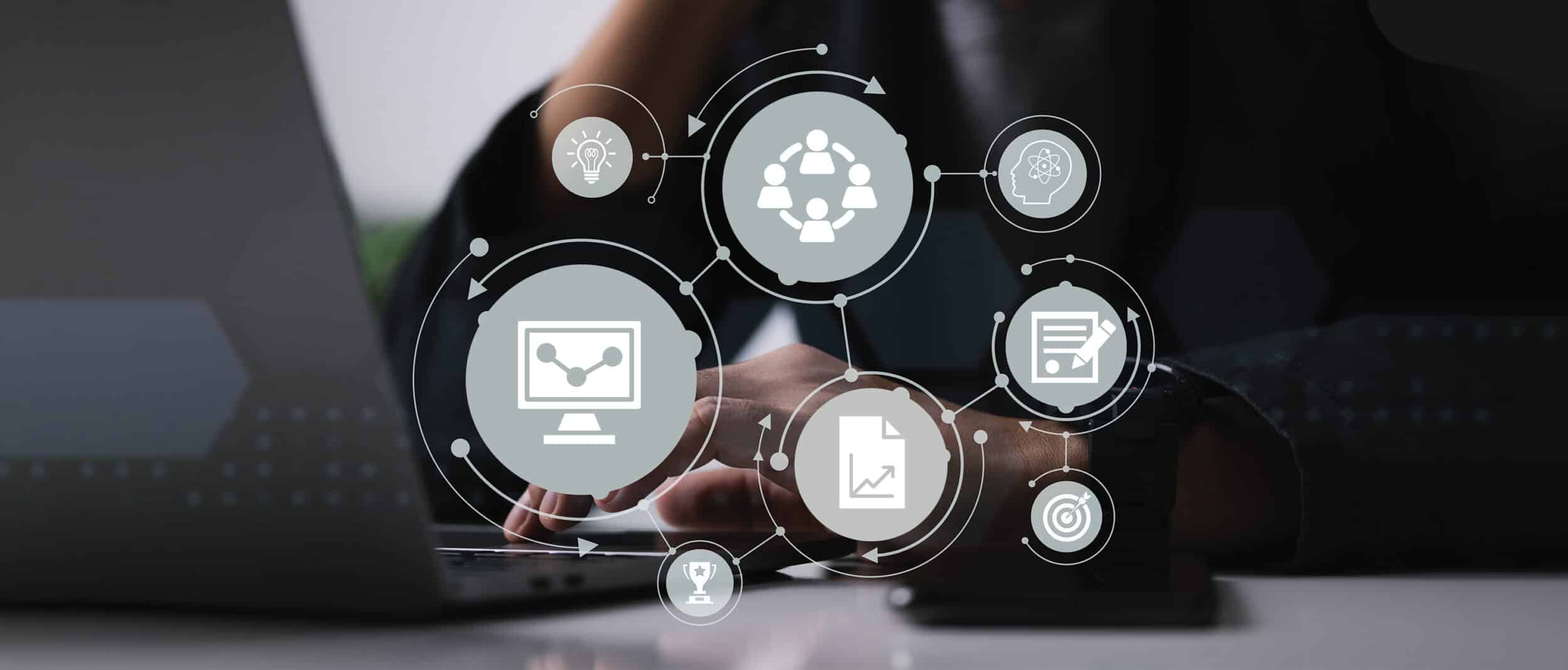The healthcare crisis caused the necessity of leveraging technology-driven solutions almost in every industry. Education is not an exception. E-learning, learning management systems, and a variety of educational platforms have already become our new normal.
Educational software has never been so in-demand as it is in recent years. More and more people engage in e-learning, as it's convenient, accessible, and easy to use. The education software market is predicted to gain $11.6 billion by 2025 compared to $10.4 billion last year.
Other statistics show that:
- there are 74 million LMS users worldwide
- companies create an LMS website as 87% of active users have web-based access
- 65% of top LMS users are corporate managers
- 90% of students prefer online learning to offline
- 4.6 million college students participate in online classes
- government institutions take 2% of the LMS software market
- 21% of the global LMS market is covered by the education segment
- e-learning course development takes up to 90% less energy compared with offline courses
Today the world experiences a massive transition toward e-learning. The market is predicted to develop more and reach $370 billion U.S. by 2026.
In the article, you will find out what an LMS system is, how to build a learning management system, and what LMS features are necessary to include.
- What’s a Learning Management System?
- Types of Learning Management Systems
- Learning Management System Development from Scratch
- Security
- Users roles and permissions
- Support
- Where to Look for Your Ideal LMS Idea?
- How Long Does It Take to Build an LMS?
- The process of LMS development at Inoxoft
- Project planning
- Analysis of requirements
- Design
- Project implementation
- Testing
- Deployment
- Maintenance
- Consider Inoxoft Your Trusted Partner in LMS Development
- Final Thoughts
What’s a Learning Management System?
A Learning Management System (LMS) is software that creates and manages content for educational purposes. Today, online courses and a variety of apps and platforms allow you to learn something new in a more convenient, faster, and less expensive way.
Companies develop a learning management system to promote the learning process with the help of
- individually-adapted content;
- content management and teacher’s notes
- student-teacher collaboration
- integrated common tools
- gamification methods
- culture-based environment
- accessible built-in analytics
Types of Learning Management Systems
To build a custom LMS, you need to understand the types of learning management systems and the differences between them. First of all, they are defined according to the purpose they have to fulfill within the particular organization. The list includes
- individual & enterprise
- commercial & free
- licensed & SaaS
- on-premise, cloud-based, & integrated
- pre-developed CMS & built-in add-ons
Let’s go through some comparisons:
| COMMERCIAL | FREE |
| For educational organizations, e.g. colleges, universities, primary course provider organization | Cost-free to build a learning platform for a specific audience. |
| Additional features are to be paid for | Numerous available features |
| Supported 24/7 updates, give access to the latest solutions. | Not much support/ updates should be handled personally |
| INDIVIDUAL | ENTERPRIZE |
| For startups or little private organizations | Build-in features to meet in-coming needs |
| One-sided/ for the single course creator | Highly scalable for everyone |
| Limited several satisfactory features | For 500+ employee organizations |
| LICENCED | SERVICE AS A SOFTWARE (SaaS) |
| For an organization | For an organization |
| On-premise/ cloud-server based | Cloud-based and scalable within time |
| Support is limited and belongs to the premium package | For upgrades / full-time tech support |
| Customizable, reliable, and flexible to each users’ needs | Customization is limited |
| BUILT-IN-ADD-ONS | CMS |
| Content authoring tools or The Experience API/ xAPI standard | Includes learning resources and project documentation |
| Ability to upload already created courses and lessons from authoring tools or LMS/CMS | L&D teams to create a course design |
| ON-PREMISE | CLOUD-BASED | INTEGRATED |
| An organization’s preferred server | Hosted by the off-site server | A blend with the existing software |
| Highly secure | Secure | Secure |
| Scalability requires more servers or the LMS is limited | Scalable and apples to all devices offline or online | Integrates with any platform |
| Features according to the specification of an organization | Many popular features are included | Compatible features |
Learning Management System Development from Scratch
Video conferencing
Video conferencing is the technology of today. So, it has to be a part of your enterprise LMS. But, what is it exactly?
Video conferencing is an online meeting technology that allows users to see each other face-to-face via a screen and talk over important things being in different locations at once. – Investopedia
Being extra convenient, video meetings are time-saving and cost-effective. They save you a lot of time on traveling and spending. Especially, when you need to meet with the stakeholders a couple of times per day.
Social boards and forums
Discussion forums are communication boards, where users can chat via messaging each other and answering questions. So, when a user decides to ask something, he/she posts a message online for everyone in the forum to read anytime. For user convenience, each message becomes threaded making it convenient to run through questions and open up various answers.
Onboarding and compliance
That’s more of an HR-related process. But it helps ease up the process of onboarding by introducing everything to the employee via an LMS. So, while introducing the new person to the company it would be quite convenient to talk about the company’s culture. And, why don’t you open up a ready-made presentation? What if there are several presentations or onboarding and compliance training to pass for a couple of days? Then you can schedule this training for an employee via the LMS. Make it a learning module. Add gamification.
Data tracking
Via an LMS it is possible to track internal, custom, and scheduled reporting. Also, you can go through course evaluation details. Or, third-party reporting tools. Just think, so many documents are gathered into one system. And, it will show you the data you need at any moment during your work. Just generate a report.
Reports and analytics
Via the feature of reporting and analytics, it is possible to track who is using your LMS (e.g. students, employees, etc.) Also, you can easily find out how they are using it. Administrators run reporting (individual, course-related, system-wide) and users might or might not see some of them.
Course creation
A good LMS allows the creation of courses using its features. And, you, as a course administrator, can make this course as unique and creative as you only wish to. This is a great feature if you have employees to train. It takes several steps and will include only what you need employees to listen to, and read, and a questionnaire they can pass after each course section.
Skills testing
First of all, it is important to decide how would you like to test your employees’ skills. Then, which skills to test. Afterward, it will be easy to set up the right questionnaires and receive employee skills reports. It is truly convenient for enterprises that have more than a hundred employees. And, with the equally conducted training courses, you will know who has learned the material and who needs to cover additional training.
Gamification
In an LMS it is another, yet quite brilliant, way to ensure learners will be excited to study. For instance, gamification allows making courses and training in the form of a game, which people can pass on a daily, weekly, and monthly basis. It depends on the course.
Security
The security of corporate and personal data is a crucial matter for any organization. The learning management system also has to be encrypted and secure from privacy disclosure or possible information leakage. So, consider adding an IP blocker, multi-factor authentication, data encryption, Backup data storage, and so on. Protected privacy increases user satisfaction and enhances positive experiences.
Users roles and permissions
To ensure data security, the feature allows editors to customize access to certain information and functionality.
Support
After signing up, users should watch training tutorials to become aware of how to navigate the platform. Also, if any errors occur might need technical support. The ability to turn to an expert and get support is an important thing.
Read more: how to create an e-learning website
Where to Look for Your Ideal LMS Idea?
The best LMS idea that can come to your head is the one that will meet your business needs. So, you need to have a target audience. For instance, at Inoxoft our target audience are our employees. Personal growth is one of our top concerns and we try to give our teams as many possibilities to learn as possible. To meet their demands and fulfill their goals, we tend to make a regular survey and get some insights from the first person. And this strategy helps. There are great ideas on how we can improve the ongoing learning processes and what has to be done in the future to support employee skill advancements and learning.
But, if you have no target audience to ask for an opinion, then consider making a deep research on the
- educational sector
- classroom progress
- university class needs
- market trends
- direct competitors
- innovative technology in eLearning
How Long Does It Take to Build an LMS?
Every project has its specificities. So, to understand what might influence project development time and costs, consider the following aspects:
- Project complexity
- LMS features
- Functionality
- Project requirements
- Availability of the team
There are other things to take into account. So, we recommend using our Inoxoft app cost calculator that will show you the approximate app estimate. And, we recommend you catch up with us for a short consultation to get the proposal with the timeline and what is going to be included. We design educational apps professionally and can meet any set deadlines if you have set the requirements and your time frames are realistic.
The process of LMS development at Inoxoft
The process of LMS development as in software development in general consists of mini sprints that are self-integral development steps. That’s what the stages look like:
Project planning
At this initial stage, the team plans how the project will be carried out. Before getting started conducting industry research, learning an idea’s value on the market, may prevent a potential failure.
We recommend answering the following questions:
- What problems will your LMS solve in the company and for users?
- Do you have competitors on the market? Who are they?
- What is the budget for LMS development?
- Who will develop it?
- Will it be customizable?
- Can it handle numerous learners or should be limited to a certain group?
- Should it include 24/7 support?
Analysis of requirements
To ensure the team is on the same page and understands what software has to be deployed 100%, the next step is to gather requirements from every project stakeholder. After this, you can think about timeframes, tech stack, design, testing, production iterations, and people involved.
Design
Since e-learning became an integrated part of our daily lives, it is not surprising that users expect their online training platform to be responsive on various devices: computers, laptops, tablets, and smartphones.
No matter how great the content is, users won’t return to a product after having a bad user experience. Design should be simple enough for users to understand without any assistance. Colors have to keep learners focused, motivate them to study, and not distract (advertising, pop-up windows, etc.)
Project implementation
When everything is being set up, the team knows what has to be done and the timeframes. The plan with iterations is also created and there are approximately two weeks before the first demo with the client.
MVP
MVP or Minimum Viable Product is the basic version of your future learning management system. The main idea is to reduce time and effort and test the idea before the full-fledged product development. We recommend starting with the MVP because this way you can test your product by building the core features, checking the working hypotheses, and getting users’ responses.
Testing
We recommend initiating testing at the beginning of the product development life cycle and involving the quality assurance team from the planning stage. This way the team will have a full understanding of the project and perform testing sessions each time there is a release. You won’t disagree that it is always better to start testing small than test the system at the end and acknowledge that it is not working.
Deployment
At this stage, each team member creates the system’s architecture according to requirements that have been discussed before. In Agile this process happens in iterations, where one feature is developed and released at a time.
Maintenance
If you need your LMS to be supported after launch, consider signing a contract with the development team. You can get constant technical support or just fix problems per request.
The question of how to create an LMS is impossible to answer without finding an experienced team. So, let’s move forward.
Consider Inoxoft Your Trusted Partner in LMS Development
Inoxoft offers education software development services and developed numerous educational projects for startups, businesses, and institutions implementing gamification, and language e-learning software to provide learners with new horizons for their self-education paths.
If you want to:
- Use built-in authoring tools to create custom enterprise courses
- Develop programs for employee training
- Establish unique training approaches
- Monitor career movements and manage mentorships
Don’t hesitate to contact our experts and create an LMS from scratch!
Final Thoughts
E-learning and LMS in particular have already become our future. This modern approach to learning is convenient, efficient, adaptable, and easy to use. If you are still interested in how to make an LMS, contact Inoxoft’s LMS developers, so they explain how to deploy a top-notch educational platform.
Frequently Asked Questions
How to build an LMS from scratch?
The process of a custom LMS development consists of the following steps:
- Project planning
- Analysis of requirements
- Design
- Project implementation
- Testing
- Deployment
- Maintenance
What are the types of LMS?
Types are defined divided according to the purpose they have to fulfill within the particular organization. The list includes:
- individual & enterprise
- commercial & free
- licensed & SaaS
- on-premise, cloud-based, & integrated
- pre-developed CMS & built-in add-ons
What is LMS?
LMS or Learning Management System is software that with help of various tools, creates and manages content for educational purposes. Today, online courses and a variety of apps and platforms allow you to learn something new in a more convenient, faster, and less expensive way.
How long does it take to build an LMS?
It depends on the LMS features, functionality, and overall project complexity.










